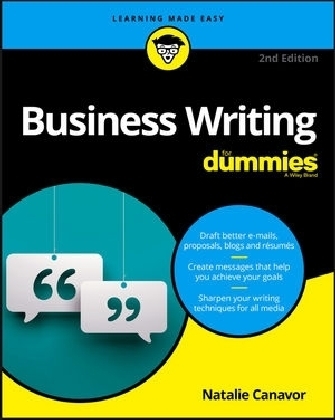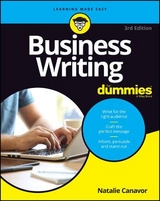
Business Writing For Dummies
John Wiley & Sons Inc (Verlag)
978-1-119-36900-4 (ISBN)
- Titel ist leider vergriffen;
keine Neuauflage - Artikel merken
Business writing that gets results The ability to write well is a key part of your professional success. From reports and presentations to emails and Facebook posts, whether you're a marketer, customer service rep, or manager, being able to write clearly and for the right audience is critical to moving your business forward. The techniques covered in this new edition of Business Writing For Dummies will arm you with the skills you need to write better business communications that inform, persuade, and win business. How many pieces of paper land on your desk each day, or emails in your inbox? Your readers the people you communicate with at work are no different. So how can you make your communications stand out and get the job done? From crafting a short and sweet email to bidding for a crucial project, Business Writing For Dummies gives you everything you need to achieve high-impact business writing.
* Draft reports, proposals, emails, blog posts, and more * Employ editing techniques to help you craft the perfect messages * Adapt your writing style for digital media * Advance your career with great writing In today's competitive job market, being able to write well is a skill you can't afford to be without and Business Writing For Dummies makes it easy!
Natalie Canavor is a business writer, magazine editor and workshop leader. She has won dozens of awards for her publications, articles and scripts. Her journalism credits include features for the New York Times, columns for business publications and advice for professional communicators. She is also the author of three books on business communication.
Introduction 1
About This Book 2
Foolish Assumptions 2
How This Book Is Organized 3
Part 1: Winning with Writing 3
Part 2: Applying Your Skills to Business Messages and Documents 3
Part 3: Writing to Present Yourself Effectively 3
Part 4: Evolving Your Writing for Online Media 4
Part 5: Extending Your Writing Skills 4
Part 6: The Part of Tens 4
Icons Used in This Book 4
Beyond the Book 5
Where to Go from Here 5
Part 1: Winning with Writing 7
Chapter 1: Make Writing Your Not-So-Secret Weapon 9
Putting Good Writing to Work for You 10
Planning and Structuring Every Message 12
Applying the Goal-Plus-Audience Strategy to All Business Needs 16
Succeeding with email, letters, and business documents 16
Writing for the spoken word 17
Writing online: From websites to blogs to tweets 18
Special purpose writing 18
Taking the global perspective 19
Chapter 2: Planning Your Message Every Time 21
Adopting the Plan-Draft-Edit Principle 22
Fine-Tuning Your Plan: Your Goals and Audience 23
Defining your goal 23
Defining your audience 25
Brainstorming the best content for your purpose 30
Writing to groups and strangers 31
Imagining your readers 32
Making People Care 33
Connecting instantly with your reader 34
Focusing on what’s-in-it-for-me 34
Highlighting benefits, not features 35
Finding the concrete, limiting the abstract 36
Choosing Your Written Voice: Tone 38
Aligning tone with the occasion, relationship, and culture 38
Writing as your authentic self 39
Smiling when you say it 40
Using Relationship-Building Techniques 41
Showing active caring and respect 41
Personalizing what you write 42
Framing messages with “you” not “I” 43
Chapter 3: Making Your Writing Work: The Basics 45
Stepping into Twenty-First-Century Writing Style 45
Aiming for a clear, simple style 46
Applying readability guidelines 47
Finding the right rhythm 50
Achieving a conversational tone 53
Energizing Your Language 54
Relying on everyday wording 55
Choosing reader-friendly words 56
Focusing on the real and concrete 57
Finding action verbs 58
Crafting comparisons to help readers 60
Employing Reader-Friendly Graphic Techniques 61
Building in white space 62
Choosing a typeface 62
Keeping colors simple 64
Adding effective graphics 64
Breaking space up with sidebars, boxes, and lists 65
Chapter 4: Self-Editing: Professional Ways to Improve Your Work 67
Changing Hats: From Writer to Editor 68
Choosing a way to edit 68
Distancing yourself from what you write 70
Reviewing the Big and Small Pictures 71
Assessing content success 72
Assessing the effectiveness of your language 73
Avoiding telltale up-down-up inflection 74
Looking for repeat word endings 75
Pruning prepositions 78
Cutting all non-contributing words 80
Moving from Passive to Active 83
Thinking “action” 83
Trimming “there is” and “there are” 84
Cutting the haves and have nots 85
Using the passive deliberately 85
Sidestepping Jargon, Clichés, and Extra Modifiers 86
Reining in jargon 86
Cooling the clichés 88
Minimizing modifiers 89
Chapter 5: Fixing Common Writing Problems 91
Organizing Your Document 92
Paragraphing for logic 92
Building with subheads 93
Working with transitions 95
Working in lists: Numbers and bulleting 97
Catching Common Mistakes 101
Using comma sense 102
Using “however” correctly 103
Matching nouns and pronouns 104
Weighing “which” versus “that” 106
Considering “who” versus “that” 107
Choosing “who” versus “whom” 107
Beginning with “and” or “but” 108
Using sentence fragments 108
Ending with prepositions 109
Fine-tuning punctuation 109
Reviewing and Proofreading: The Final Check 112
Checking the big picture 112
Proofreading your work 114
Creating your personal writing improvement guide 115
Part 2: Applying Your Skills to Business Messages and Documents 119
Chapter 6: Writing Messages That Get Results 121
Fast-Forwarding Your Agenda with Email 122
Starting Strong 124
Writing subject lines that pull people in 124
Using appropriate salutations 127
Drafting a strong email lead 127
Building Messages That Achieve Your Goals 128
Clarifying what you want 129
Assessing what matters to your audience 130
Determining the best content 132
Structuring Your Middle Ground 134
Closing Strong 136
Polishing Your Email 136
Monitoring length and breadth 137
Simplify style 137
Going short: Words, sentences, paragraphs 138
Using graphic techniques to promote clarity 138
Using the signature block 140
Good Letter Writing Techniques 141
Chapter 7: Creating High-Impact Business Materials 145
Creating Valued Reports 146
Writing activity reports 146
Reporting project results 151
Fast-Tracking Your Proposals 152
Writing formal proposals 152
Writing informal proposals 155
Applying for grants 158
Writing an Executive Summary 160
Giving perspective to complex material 161
Determining what matters 162
Putting headlines to work 163
Writing Tips for All Business Documents 165
Part 3: Writing to Present Yourself Effectively 167
Chapter 8: Speaking Well for Yourself 169
Building Your Elevator Speech 170
Defining your goal 171
Defining your audience 171
Strategizing your content 172
Representing your organization and yourself 175
Preparing and Giving Presentations 177
Planning what to say 177
Crafting your presentations with writing 181
Integrating visuals 182
Standing and delivering 184
Composing Talking Points for Live Interaction 185
Chapter 9: Telling Your Business Stories 189
Finding Your Core Business Message 190
Searching for true value 192
Making your case in business terms 195
Finding, Shaping, and Using Stories 196
Finding your story 197
Building your story 198
Story-writing tips 199
Putting stories to work 201
Telling Your Story with Video 202
Deciding how to use video 203
Using video for marketing 205
Introducing yourself with video 206
Sharing expertise with video 207
Chapter 10: Writing for the Job Hunt 209
Knowing and Expressing Your Value 210
Pinpointing your personal strengths 210
Pulling your ideas together 212
Writing Résumés That Win the Race 215
Choosing a format 216
Writing the summary statement 218
Building your work history section 219
Showing off strengths 221
Succeeding with Cover Letters 222
Planning a cover letter 222
Opening with pizzazz 223
Networking with Messages 224
Requesting informational interviews 224
Saying thank you 227
Part 4: Evolving Your Writing for Online Media 229
Chapter 11: Writing for the Digital World 231
Positioning Yourself Online 232
Strategizing Your Platform Choices 233
Breaking down your goals 235
Knowing where your audiences are 236
Assessing your skills and potentials 239
Writing for Digital Media 239
Loosening up 240
Keeping it simple and visual 241
Communicating credibility 242
Cutting hype, maxing evidence 243
Devising nonlinear strategies 244
Incorporating interactive strategies 244
Translating text into visuals 245
Chapter 12: Creating Your Online Presence 249
Creating a Website from the Ground Up 250
Determining goals, format, and audience 251
Planning a basic website 252
Creating the site structure 254
Assembling and writing a home page 255
Writing the About Us page 257
Writing the inside pages 258
Graphic tips for websites 259
Creating a Blog 260
Choosing your best subject 262
Developing tone and style 263
Creating magnetic headlines 263
Using progressive subheads 265
Networking with Twitter 265
Planning your Twitter program 266
Guidelines for tweeting 266
Writing Online Profiles 268
Using Social Media Platforms 269
Engaging with social media 270
Exploring content ideas 272
Part 5: Extending Your Writing Skills 275
Chapter 13: Writing and the Independent Worker 277
Writing Persuasively Cross-Media 278
Communicating with conviction 278
Connecting with your reader 280
Maintaining reader engagement 281
Giving people time 281
Introducing Yourself in Writing 282
Writing to Pitch Your Services 286
Creating Letters That Sell 288
Writing Difficult Messages 290
Spelling out services performed 290
Collecting on your invoices 291
Raising your fee structure 294
Communicating as a Virtual Worker 296
Pitching the Media 297
Writing traditional “press releases” 298
Writing email pitches 299
Finding ideas for the media 301
Chapter 14: Writing Well to Manage Well 303
Communicating as a Manager 304
Relating to your team members 305
Writing to inspire and motivate 306
Delivering bad news 307
Writing good news messages 313
Criticizing with kindness 314
Writing requests and giving orders 315
Writing to Higher-Ups 316
Guarding your tone 318
Avoiding the blame game 320
Making it easy to respond 321
Writing Backup Memos 323
Part 6: The Part of Tens 325
Chapter 15: Ten Ways to Advance Your Career with Writing 327
Write to Build Relationships 327
Write a Great Elevator Speech 328
Write Your Own Long-Range Career Plan 328
Write an Ad for Your Dream Job 328
Go Out of Your Way to Thank People 329
Take Notes to Control the Conversation 329
Use Social Media Strategically 329
Know How to Explain Your Value 330
Profile Your Higher-Ups 330
Create Talking Points 330
Chapter 16: Ten Ways to Energize Your Résumé 331
Don’t Apply for the Job You Have Now 331
Adopt the Employer’s Language 332
Write Clearly and Concisely 332
Communicate What You Actually Do 332
Write Narratives, Not Just Bullets 333
Sidestep Jargon and Business-Speak 333
Use Action Verbs to Prove What You Accomplished 333
Write in a Confident, Positive Tone 334
Incorporate Keywords 334
Make It Look Good 334
Chapter 17: Ten Steps to Creating Video 335
Know Your Goal, Know Your Audience 336
Plan Your Production Style and Content 336
Write a Word + Picture Script 336
Create a Shot List 337
Lights, Action, Camera 337
Review Your Shoot and Other Resources 337
Find a Good Lead 338
Match Picture and Words 338
Craft the Right Words 338
Let Me Entertain You 339
Index 341
| Erscheinungsdatum | 19.05.2017 |
|---|---|
| Verlagsort | New York |
| Sprache | englisch |
| Maße | 187 x 237 mm |
| Gewicht | 686 g |
| Themenwelt | Sachbuch/Ratgeber ► Beruf / Finanzen / Recht / Wirtschaft ► Wirtschaft |
| Geisteswissenschaften ► Sprach- / Literaturwissenschaft ► Literaturwissenschaft | |
| Wirtschaft ► Betriebswirtschaft / Management | |
| ISBN-10 | 1-119-36900-2 / 1119369002 |
| ISBN-13 | 978-1-119-36900-4 / 9781119369004 |
| Zustand | Neuware |
| Informationen gemäß Produktsicherheitsverordnung (GPSR) | |
| Haben Sie eine Frage zum Produkt? |
aus dem Bereich



